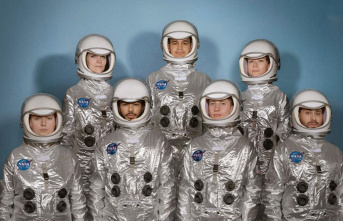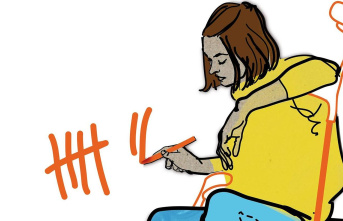Russia's war against Ukraine has entered a new phase. The battles for the small towns of Bakhmut and Soledar in the north of the Donetsk region are the bloodiest fighting in months. With mighty force, the troops of President Vladimir Putin dented the front at this point. Supported by massive artillery fire, infantrymen—mostly ex-convicts recruited by the Wagner mercenary force—stormed the Ukrainians' well-fortified defenses. Despite stubborn resistance, they slowly but steadily advance position by position, house by house.
There are no exact figures, but both sides speak of high losses. Russia has turned the spot into a "hell on earth," complains Ukrainian presidential adviser Mykhailo Podoliak. According to President Volodymyr Zelenskyy, both cities have been completely destroyed. "It's very difficult: There are hardly any intact walls left there," said the 44-year-old, describing the situation last week.
After the painful defeats in autumn, when Russian troops had to withdraw from the Kharkiv region in the north and later from Cherson in the south of Ukraine, the attack on Bakhmut and Soledar gave Moscow the upper hand, at least in the media. How important the announced acquisition of Soledar is to the Kremlin can be seen in the bitter dispute between the Ministry of Defense and the financier of the Wagner troupe, Yevgeny Prigozhin, over who should pin the success on their lapels. The dispute reveals a dispute over competences, which from the Russian point of view is questionable for the further course of the war.
Militarily, the Russian capture of Soledar, which Kyiv continues to deny, is at best a tactical success. The city, which had a little over 10,000 inhabitants before the war, is part of the ramparts that were built east of the conurbation between Slowjansk and Kramatorsk. But there are other lines of defense behind them as well. "Ukrainian defenses are not collapsing," says former Russian intelligence officer Igor Girkin, who, using the pseudonym Strelkov, led the 2014 separatist uprising in eastern Ukraine. Sloviansk and Kramatorsk are the best developed fortified areas in Ukraine, he says.
The rumored demand from Kremlin chief Vladimir Putin to his new supreme commander in Ukraine, Valeri Gerasimov, to take the Donbass by March can only be achieved with fresh forces. That's why speculation about a new mobilization is increasing - despite the almost daily denials from the Kremlin.
Moscow can probably only start a new major offensive after further mobilization. It doesn't matter whether the Russian military continues to use frontal attacks in the Donbass or evasion maneuvers from Zaporizhia in the south and possibly even from Belarus in the north. All three variations are circulating among military experts, but none of these potential strikes are promising without reinforcements.
Negotiations currently seem more hopeless than ever. Both sides are a long way from their political goals. Kyiv wants to expel the Russians entirely from their own country, including the Crimean Peninsula, which was annexed in 2014. Moscow, on the other hand, claims all of the Donbass and the southern Ukrainian regions of Zaporizhia and Cherson, which were annexed in the autumn, but only partially controls them. The stated preconditions for the resumption of dialogue are unrealistic as long as there are no changes at the front.
Ukraine hopes to force these changes with Western military assistance. In doing so, she relies specifically on the meeting of defense ministers in Ramstein, Germany, at the end of the week. "300 tanks, 700 armored personnel carriers and 500 howitzers," Chief of Staff Valeriy Saluschnyj said in an interview with the British "Economist" as the target for a successful large-scale offensive. The Czech Republic begins to deliver 100 refurbished T-72s. Poland's President Andrzej Duda hopes that European countries will be able to provide 100 Leopard tanks. 14 are delivered by Poland itself, but the yes from Berlin is still missing.
In addition, the tanks could not immediately roll to the front due to a lack of maintenance. With the necessary training of the crews and the establishment of the logistics for ammunition and spare parts, it could still be months before these actually go into action. It's too late for the hoped-for Ukrainian spring offensive.
And after the massive losses at Soledar and Bakhmut, Kyiv is apparently also slowly running out of soldiers. The mobilization that has been going on since the beginning of the war is apparently being intensified. In the Kiev district of Holossiyiv, all men of military age should report to the district military replacement office by the end of the month if they are threatened with punishment. Videos of summonses being distributed on the streets of the major cities of Odessa, Kharkiv and Mykolaiv are making the rounds on social networks. At the same time, the Ministry of Defense constantly asserts that there is no additional need.
Because of its size, Russia still has an advantage in terms of human resources, according to Ukrainian military expert Oleh Zhdanov. "We wear down the enemy and don't give them the opportunity to build up reserves," he says, explaining the long wait of the Ukrainians in places like Bakhmut. Ukraine can only survive if it continues to destroy Russian troops and at the same time build up reserves itself. However, he does not dare to say when new Ukrainian troops will be deployed for a counterattack.
"As soon as we have gathered enough forces for a counterattack, the General Staff will start the counteroffensive, while the losses of the Russian army must be kept as high as possible," Zhdanov said. Because a premature attack, for example in Zaporizhia, where speculation has been going on for months about a Ukrainian advance towards the sea, could be fatal and end in a counterattack. The next few weeks will show which side is first able to pool the necessary resources on a front section.











